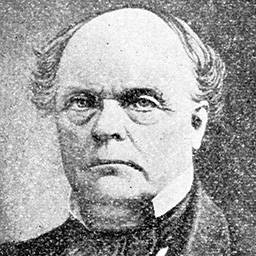
(Dec. 24, 1794-Aug. 13, 1877). A native of Wethersfield, Connecticut, Rose had no education beyond common school. He moved west in 1817 at age 23, and, after traveling the Ohio and Mississippi river valleys for two years, he settled in Terre Haute, Indiana. He opened a lumber mill, became a retail merchant, and began to buy land in what would become the city’s downtown. By the late 1840s, Rose was Terre Haute’s most prominent citizen.
Although he became a stockholder and director of the Wabash and Erie Canal, Rose soon saw that railroads would make canal transportation obsolete. Thus, with his own money and what he could raise from friends and associates, he undertook an endeavor to build a railroad. At his urging, the Indiana General Assembly passed an act in 1847 to incorporate his Terre Haute and Richmond Railroad Company.
In May, delegates from several Indiana counties gathered in Indianapolis at a convention to discuss the possibility of connecting St. Louis with Cincinnati, an action that would result in “continuous railroad communication with the eastern Atlantic cities.” That was precisely what Rose, one of the convention organizers, had in mind. Subsequently, he joined with representatives of three other railroads—the , the Peru and Indianapolis, and the Indianapolis and Bellefontaine—as well as prominent citizens of the capital city to establish a joint rail track and depot in Indianapolis.
The Indianapolis Union Railroad Company was organized in 1850 with Rose as president. Its facilities, which opened on September 20, 1853, were the first union tracks and station in the United States. The tracks from Indianapolis to Richmond—later the Indiana Central Railroad Company—were completed in time for the grand opening of the east-west rail connection in 1853.
By 1877, the year of his death, Rose’s original enterprise, which was then named the Terre Haute and Indianapolis Railroad Company, had large holdings in western Indiana and eastern Illinois. Thus, while not a resident of Indianapolis, Rose had a significant impact on the development of the capital city’s railroad network and facilities during the 19th century.
Rose had no heirs and set out in his later years to distribute his wealth in a way that would bring the most benefit to society. His many philanthropies included the library of the State Normal School (Indiana State University) and Rose Polytechnic Institute (Rose-Hulman Institute of Technology).

Help improve this entry
Contribute information, offer corrections, suggest images.
You can also recommend new entries related to this topic.